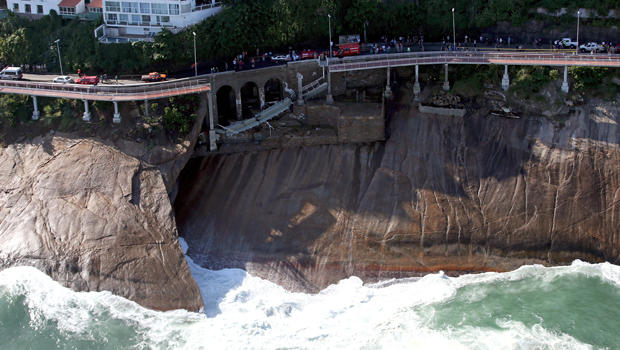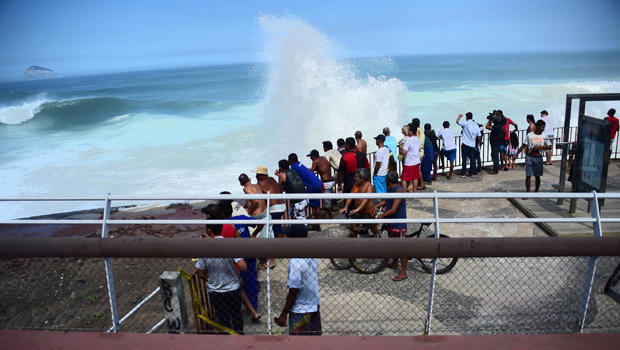Last Updated Apr 21, 2016 4:24 PM EDT
RIO DE JANEIRO — At least two people were killed Thursday in the collapse of a new elevated bike path that has been heralded as a top legacy project of the Rio de Janeiro Olympics.
The accident on the Tim Maia bike path is the latest in a series of problems besetting preparations for the Aug. 5-21 games, which include worries about an outbreak of the Zika virus, political turmoil that threatens to topple President Dilma Rousseff, underwhelming ticket sales and budget cuts amid Brazil’s worst recession in decades.
Municipal Secretary Pedro Paulo Carvalho said a third person was thought to be missing after a giant wave apparently swept up a rocky cliff, lifted an approximately 150-foot stretch of the bike path and sent it plunging onto the rock and sea below.

An aerial view of a bike lane that collapsed on April 21, 2016, in Rio de Janeiro, Brazil.
Rio’s fire department only confirmed the two deaths. Local news media said two other people were rescued alive.
Helicopters fished the two who died out of the water and laid them out on the golden sands of Sao Conrado beach. Initially covered by colorful beach sarongs, they were later shrouded by a sheet of black plastic.
Waves periodically washed over the bodies. A crowd of beachgoers gathered round the corpses, while others continued a game of beach soccer nearby.
Joao Ricardo Tinoco identified one of the victims as his brother-in-law, Eduardo Marinho Albuquerque. He said the 54-year-old father of one was out jogging at the time of the accident. Tinoco’s sister, Eliane, kneeled over his body, kissing his face and begging for another moment to “say goodbye.”

People look below after a recently inaugurated bicycle lane collapsed in Rio de Janeiro, Brazil, on April 21, 2016.
Carvalho was asked whether shoddy construction – a perennial problem in Brazil, where graft is a fixture of many construction projects – might be to blame for the accident. He said it was too early to tell and said an investigation is underway to determine the cause of the collapse.
“It’s clear that an accident like this is unpardonable,” Carvalho told the Globo television network.
The entire 2.5-mile bike path, which links the tony beachfront neighborhoods of Sao Conrado and Leblon, is now closed, Carvalho said.
Thursday was a public holiday in Brazil, and with the weather sunny and warm, the city’s bike paths, beaches and other outdoor recreational spots were packed.
The bike path is perched high above the water on concrete and metal pillars set into the rocky cliff. Inaugurated on Jan. 17 with much fanfare, the 45 million Brazilian real ($12.5 million) project was initially heralded as one of the most successful Olympic legacy projects, earning kudos for its spectacular views. But soon detractors began to complain that the brand-new structure was already showing signs of deterioration and that the narrowness of the path made cyclists easy prey for muggers.
The bike path runs parallel to a road high above the sea that will be used for the road-cycling event in the Olympics. Construction is underway to extend the bike path westward to the Barra da Tijuca neighborhood that is one of the Olympic hubs and Carvalho said engineering of that stretch would face extra scrutiny.
In an emailed statement, Rio’s Olympic organizers said “our thoughts and sympathies are with the people and their families and friends affected by the tragic accident.”
The collapse happened just hours after the flame for South America’s first Olympics was kindled at the Greek birthplace of the ancient games. Carlos Nuzman, the head of the Rio de Janeiro organizing committee, expressed optimism speaking at the ceremony.
“We are incredibly proud to have come so far, sailing through some of the most challenging waters the Olympic movement has seen,” Nuzman said before hearing of the accident, adding that the Olympic flame “brings a message that can and will unite our dear Brazil.”
The kindling of the flame begins a 15-week journey that will culminate with the Aug. 5 opening ceremony in Rio.



